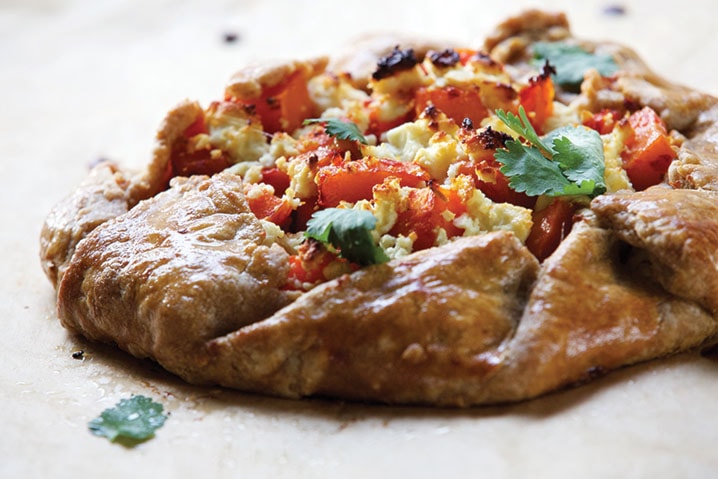If you like savoury pies and tarts but find the whole crust process to be intimidating, I’ve got one word for you: galette. In case that doesn’t mean anything, I’ll give you two more: free-form.
With a galette, you roll out the crust, sure, but you don’t need to trim it or, really, spend much time shaping it. Go ahead and leave the edges ragged. You don’t even need to get all that close to a reasonable circle, either. Pile the filling in the center, pull the outside edges of the pastry up and over a little bit — letting plenty of the filling stay exposed — and loosely pleat it. The rougher, the better.
That brings us to the fourth word: rustic. Now you’re getting the picture.
I know that people make galettes (crostati in Italian) in the summer, but my preferred time to make them is in the colder months, when the warmth of the oven takes the chill off the kitchen and when seasonal produce is hearty enough to stand the long cooking time. There are lots of ways to go here. You can use cauliflower or broccoli or a combination with romesco (my favourite) or another sauce, or combine cooked-down greens and canned or home-cooked beans with lots of garlic, onion, celery and Cajun spices.
My new go-to is from Emma Galloway’s beautiful 2015 book, My Darling Lemon Thyme. It features a combination that hadn’t occurred to me before, and it worked beautifully: winter squash tossed in a good amount of harissa, the spicy north African pepper paste, and roasted until tender. You pile it on that pastry, top with feta, do that pleating thing, and bake until crisp. The harissa’s sharpness mellows out a little, the squash gets wonderfully soft, and the feta adds a briny zing.
The filling is a three-ingredient recipe, without the need for even salt and pepper. And if you have dough for a crust awaiting you in the freezer, all the better. But in case you don’t, Galloway used a gluten-free one with hers, and it looks intriguing, made with mashed potato and two GF flours.
I knew I’d instead use one of my favourites: a rye-based dough inspired by a recipe from Good to the Grain author Kim Boyce. It adds another touch of earthiness to the affair, and, in the spirit of a galette, it’s just as simple.
Harissa Squash
and Feta Galette
MAKES: 4 to 6 servings
PREPARATION: The dough for the galette crust needs to be refrigerated for at least 1 hour and up to overnight.
Mina brand harissa can be found on the hot-sauce aisle at some Harris Teeter stores; Cava Mezze harissa is available in the refrigerated section of some Whole Foods Markets.
Filling recipe adapted from My Darling Lemon Thyme, by Emma Galloway (Roost Books, 2015); crust recipe adapted from Good to the Grain, by Kim Boyce (Stewart, Tabori & Chang, 2010).
Ingredients
For the crust
1/2 cup dark or light rye flour
1/2 cup all-purpose flour
1/2 teaspoon kosher salt
6 tablespoons chilled vegan shortening (may substitute butter or coconut oil)
4 to 6 tablespoons ice water
1/2 teaspoon apple cider vinegar
For the galette
2 pounds butternut or other winter squash, peeled, seeded and cut into 1-inch chunks
1/2 cup harissa (store-bought or homemade; see related recipe and headnote), or more for serving
3 ounces feta cheese, crumbled
1 large egg yolk
2 teaspoons whole milk
Cilantro leaves, chopped, for garnish
Steps
For the crust: Combine the rye flour, all-purpose flour, salt and shortening in a food processor; pulse a few times, until the shortening is mostly the size of peas, with some bigger pieces. Add 4 tablespoons of the ice water and the vinegar; pulse a few times, until the dough mostly comes together as one lump with a few shaggy pieces. Turn the dough onto a sheet of plastic wrap and squeeze it to see if a ball forms. If it is too dry to come together, sprinkle with more ice water, 1 tablespoon at a time, mixing with your hands until it does. Press the dough into a disk, wrap it tightly in the plastic wrap and refrigerate for at least 1 hour (and up to overnight).
For the galette: Preheat the oven to 350 degrees. Lightly grease a rimmed baking sheet with cooking oil spray; have another baking sheet at hand.
Combine the squash and harissa in a large bowl, mixing thoroughly to coat. Turn the squash pieces out onto the greased baking sheet; roast for 30 to 35 minutes, turning them a few times during cooking, until they are tender. Let cool.
Lightly flour a work surface, or have two sheets of parchment paper at hand. Unwrap the galette dough; roll it out on the floured surface or between the parchment paper sheets to a round that’s about 12 inches across. Transfer to the second baking sheet (on a piece of the parchment paper) and top with the roasted squash at the center, leaving a 2-inch border. Scatter the feta on top of the squash, then fold the edges of the dough toward the center, loosely pleating it as needed, to form the galette. (There should be a fair amount of squash and feta exposed at the center.)
Lightly whisk together the egg yolk and milk in a small dish, then brush the mixture on the dough. Bake until the crust is crisp and golden and the feta is browned, 40 to 45 minutes.
Garnish with cilantro leaves. Serve hot or at room temperature, with extra harissa on the side, if desired.
